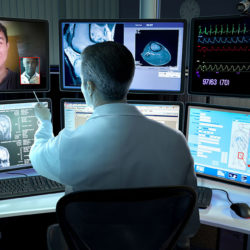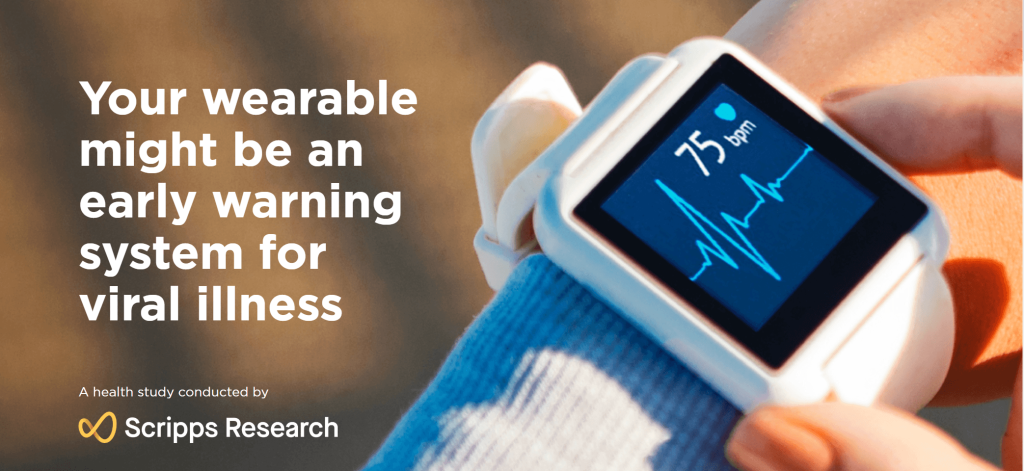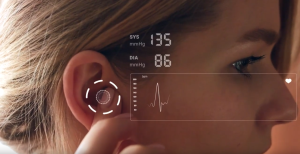The Inflection Point for Remote Patient Monitoring with Wearables
The COVID-19 pandemic has created chaos and uncertainty in nearly every corner of the world. But with this uncertainty is an opportunity to rapidly accelerate digital health and remote patient monitoring. And that appears to be happening now. What would have likely taken 5-10 years if not longer is happening in 1-3 years – some think even faster. Dr. Sam Wessely, a general practitioner in London, told the New York Times, “We’re basically witnessing 10 years of change in one week”.
 Telemedicine, in particular, is seeing rapid acceleration:
Telemedicine, in particular, is seeing rapid acceleration:
“During the month of February, we did about 1,000 virtual visits in our adult health care delivery system. One day a week now, we do more than 3,000 — so about a 50-fold increase,” said Lloyd Minor, Dean, Stanford Medical School. “What we’re discovering is that we can do a lot more through a virtual visit than we thought we could in the past. And yet I’m also sure we are only scratching the surface.”
Only scratching the surface indeed.
In parallel, we’re seeing this as an inflection point for biometric wearables and hearables in remote patient monitoring. By now it’s clear that wearables are being recognized for their ability to track real-time biometric signals across a large percentage of the population. In fact, numerous studies involving wearables have been launched in the midst of the COVID-19 pandemic:

- Stanford Medicine scientists hope to use data from wearable devices to predict illness, including COVID-19
- Scripps Research invites the public to join an app-based DETECT study, leveraging wearable data to potentially flag the onset of viral illnesses
- New study aims to use health data from a smart ring to identify coronavirus symptoms
- Duke researchers to collect biometrics from wearables in search for early COVID-19 detection method
In general, we’ve seen two primary use cases emerge for biometric wearables in remote patient monitoring:
- Acute monitoring – This use case is primarily in the context of spot checks like a telemedicine appointment where a medical provider needs inputs of current vital signs and health metrics in order to make an assessment or diagnosis. In these scenarios, the wearable devices are focused on point-in-time biometric data, essentially replacing the vital sign checks that are typically done in a doctor’s office – core body temperature, blood pressure, heart rate, blood oxygenation (SpO2), and respiration rate.
- Continuous monitoring – This use case is primarily centered around biometric monitoring, tracking biometrics and signals in the background, establishing a baseline, and then providing care when there is a deviation from the baseline. Often used in tracking pre-cursors and/or symptoms associated with metabolic disease – heart disease, stroke, and type-2 diabetes. Wearables in this context are primarily used for tracking heart rate trends, energy expenditure, respiration rate, and body temperature. The goal with continuous monitoring is first as an “early warning system” for known issues, and second, providing longitudinal and contextual data that will enable predictive analytics to flag issues before known issues occur.
It’s important to note that the COVID-19 pandemic is highlighting what can be done with existing sensor technology. Wearables measuring heart rate, heart rate variability, respiration rate, and SpO2 have been around for many years, decades in some cases. More recently clinical studies are beginning to show efficacy. In 2018 wearables were shown to provide an “early warning system” for acute infection and illness related to influenza based only on changes in resting heart rate and activity levels. The report concluded, “This information could be vital to enact timely outbreak response measures to prevent further transmission of influenza cases during outbreaks.”
“Only scratching the surface”
Telemedicine and wearables are only scratching the surface of what’s possible today. For example, hypertension is not talked about as much in the context of COVID-19, but perhaps it should be. COVID-19 has shown much higher levels of mortality associated with comorbidities, particularly blood pressure (In Italy, 75% of COVID-19 fatalities had high BP).In addition, a recent study of New York COVID-19 patients found of the 5,700 people hospitalized due to COVID-19, 57% had high BP. BP can now be monitored in hearables using Valencell technology.
Core body temperature is another hot topic (pardon the pun) given its relevance to COVID-19. It’s long been known that heart rate increases with fever – each degree increase in body temperature corresponds to an 8-BPM increase in heart rate (Liebermeister’s rule). This of course requires knowing a person’s normal resting heart rate to recognize an increase in heart rate – something easily accomplished with wearable sensor technology. Skin temperature sensors in wearables can also provide indications of fever or illness trending.
In many cases, heart rate variability (HRV) provides an even better leading indicator of health. HRV measures the variability in time between beats of the heart and has been extensively proven in numerous studies to be an indicator of the autonomic nervous system and individuals’ stress levels, whether physical stress (including your body fighting off infection) or psychosocial stress. Once an individual’s baseline is established, HRV can provide insights in acute monitoring of fatigue, sleep quality, and physical fitness, as well as insights into serious health conditions such as atrial fibrillation or cardiovascular deterioration.
As an example, HR and HRV can be used in tandem as a more effective “early warning system” for illness. When resting HR goes up and HRV goes down, an individual is much more likely to get sick or may already be on that path.
In addition, other physiological parameters measured by wearables can also offer insights:
- Respiration rate – As seen with many respiratory illnesses, respiration rate can also be an indicator of a body that is fighting off illness. Respiratory rate also has many validated clinical uses, including as a predictor of early clinical deterioration after Emergency Department (ED) discharge.
- Blood oxygenation (SpO2) – However, respiratory illness is not always accompanied by increased respiration rate. Some cases of COVID-19 have shown what’s known as “silent hypoxia” in which patients show no signs of breathing troubles, but their blood oxygenation is very low.
- Activity context – Simple activity tracking can highlight changes in how much a person is moving compared to their normal routine, which has been demonstrated to be an indicator of illness or injury.
Valencell goes even further
At Valencell, we are laser-focused on generating valuable insights from our wearable biometric sensors, particularly for digital health and remote patient monitoring.
We’ve created PPG sensor systems, analytics, and assessments for acute monitoring of virus symptoms like COVID-19, but also continuous monitoring of chronic conditions as well. With a single sensor system, Valencell can measure:
- Heart rate – continuous, motion-tolerant heart rate
- R-R Interval – for HRV calculations
- Blood pressure
- Respiration rate
- SpO2
- Cardiac efficiency
Valencell also provides unique insights about the PPG data that can be valuable in research and patient monitoring, including:
- Signal quality – so you know when you can trust the data and when there may be something corrupting the signal
- Pulsatile and non-pulsatile amplitude – which provide insights into blood flow characteristics, including pulse pressure and respiration rate
- Raw accelerometer data – which can be used for other capabilities such as fall detection
Valencell’s technology also has the flexibility to be deployed in many different device types and body locations. And body location matters when it comes to biometric wearables, as we outlined in detail in this blog post. For example, you can do things at the ear that are much harder (or impossible) at the wrist and other body locations. We can help inform the decision on the best form factor/body location for your use case, providing design guidance on the device and recommendations on how the insights are presented to the patient or the user.
All of these capabilities exist today at Valencell and we have evaluation kits available that can be used to validate use cases, device types, and analytics.
Customers trust Valencell to enable biometric use cases that no one else can.
If you are building a biometric wearable, Valencell provides everything from advanced biometric sensor technology to groundbreaking biometrics and user experiences. We deliver a complete biometrics solution for your wearable or hearable device. Contact us at [email protected] to start collaborating. We look forward to hearing from you.